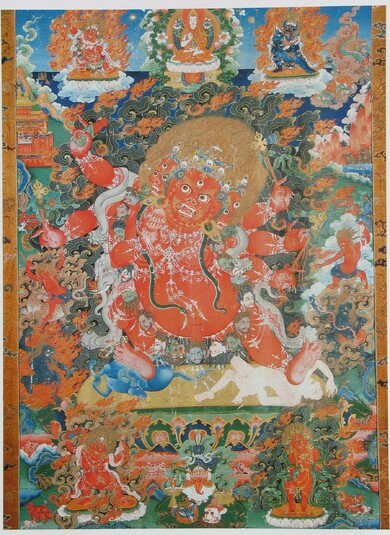
Item: Begtse Chen (Buddhist Protector) - Secret Accomplishment
| Origin Location | Tibet |
|---|---|
| Date Range | 1800 - 1899 |
| Lineages | Gelug and Buddhist |
| Material | Ground Mineral Pigment on Cotton |
| Collection | Publication: A Tale of Thangkas |
Classification: Deity
Appearance: Wrathful
Gender: Male
Chamsing, 'Brother & Sister, Secret Accomplishment'. There is an inscription on the top of the brocade mount on the reverse which reads 'left four, Brother & Sister, Secret Accomplishment' (g.yas bshi pa lcam sring gsang sgrub). The 'left four' is a placement instruction for hanging the composition within the larger set of paintings. No other compositions from this painting set are currently known.
Iconographic Elements of the Painting: Size, Descending Order & Hierarchy: - Chamsing (central image) - Lama Tsongkapa (top center) - Hayagriva & Heruka Vajrabhairava - four attendant figures, unknown (middle right) - Male figure, unknown (bottom left) - Female figure, unknown (bottom right)
Artistic Elements of the Composition: - Subject: figurative - Composition Type: Floating Figure - Ground Colour: Multi-coloured - Painting Style: New Menri - Painting Set: Yes - Others from the set: Dieux et demons de l’Himalaya, 1977, #224, HAR #85150 - Region: Central Tibet - Date: 19th century - Inscriptions: back of brocade mount, top - Back of Painting: plain - Artist: unknown at this time - Comparables by Subject: none known - Comparables by Style:
Chamsing is wrathful in appearance, red in colour, with three faces, six arms and ithyphallic. In the right hands he holds a heart, an ax and a red phallus. In the left hands he holds a hook, a lasso and a hammer. He wears bone ornaments, a garland of freshly severed heads, a large green snake and an elephant skin. Standing with the right leg bent and the left straight he presses down onto the bodies of a naked man and a blue horse atop a sun disc and multi-coloured lotus blossom.
On the right and left sides of Chamsing are four attendants, red and blue, with one riding a leopard. At the bottom left is a male figure, wrathful, red, with one face and two arms. The right hand holds aloft a phallus and there is a shield in the left hand. Wearing a human skin and bone ornaments he is in a standing posture surrounded by smoke and licks of flame. At the bottom right side is a female figure, wrathful, red, performing a gesture at the heart with both hands. Wearing a green scarf and gold ornaments she stands with the legs together surrounded by dark smoke and orange flames.
At the top center is Lama Tsongkapa. At the left is Hayagriva, red, with one face and two hands. On the right side is Heruka Vajrabhairava, blue in colour, with one face and two hands embracing the consort Vajra Vetali.
The name 'chamsing secret accomplishment' could imply that this image of a three faced wrathful deity is a form of Chamsing Begtse Chen. There are several elements that support an identification of Chamsing Begtse. First, Begtse is related to Hayagriva, the red deity, who is pictured at the top left corner. The prone human figure and the blue horse underfoot are identical to the iconography of Begtse. The two figures at the bottom of the composition, a male and a female, are similar to the two side attendants of Begtse. The figure of Chamsing also bears a striking iconographic resemblance to Lha Chenpo a Tantric Buddhist form of the Hindu god Shiva. Both Chamsing "Secret Accomplishment' and Lha Chenpo are red in colour, stand naked, are ithyphallic and both hold a phallus in the upraised right hand.
Jeff Watt 1-2016
Reverse of Painting
English Translation of Inscription: right four.
Wylie Transliteration of Inscription: g.yas bshi pa lcam sring gsang sgrub.
Special Features: (Printed script (Uchen))
Buddhist Protector: Begtse Chen (Masterworks)
Painting Set: Protectors (Lelung Zhepa'i Dorje)
Buddhist Protector: Begtse Chen Main Page
Buddhist Worldly Protector: Lha Chenpo Main Page
Subject: Ithyphallic Art
Buddhist Worldly Protector: Lha Chenpo (Masterworks)
Publication: A Tale of Thangkas
Buddhist Protector: Begtse Chen Iconography


